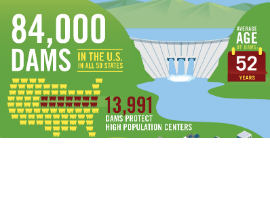Earlier this week, the Center for American Progress(CAP) released a report on U.S. dams, Aging Dams and Clogged Rivers: An Infrastructure Plan for U.S. Waterways. The report makes the economic case for the need to increase investment in our infrastructure, citing ASCE’s Failure to Act economic study that found we’re currently paying about half our nation’s infrastructure bill across 10 categories of infrastructure. It also points to the safety risks of this underinvestment, particularly given the “D” grade for our nation’s dams in the 2013 Report Card for America’s Infrastructure.
The report was released with a panel discussion with stakeholders ranging from the Nez Perce Tribe to the Deputy Secretary of the Interior.
Dams tend to be among the more forgotten pieces of infrastructure, given attention primarily when something goes wrong. This report is helping to raise awareness about the importance of dam infrastructure, and the challenges our nation’s 84,000 aging dams are facing. While many dams perform useful purposes, such as drinking water, irrigation, hydropower, flood control, and recreation. However, others have outlived their useful lives, no longer serving the purpose for which they were intended.
Repairing, rehabilitating, and removing dams is costly. The Association of State Dam Safety Officials estimates that it will require an investment of $21 billion to repair aging, yet critical, high-hazard dams. But there are solutions that can help address these challenges, increasing our dam safety.
One is in Senate’s version of the Water Resources Development Act (WRDA), which creates a national dam rehabilitation program to repair, rehabilitate, and remove non-federal dams. It is now up to the leaders of the Senate Environment and Public Works Committee and House Transportation and Infrastructure Committee to include this valuable program in the final version of the bill.
CAP’s report also includes policy recommendations to increase our dam safety, including incentivizing the removal of obsolete dams and modernizing dams the are providing useful service.
Stay tuned to find out if the National Dam Rehabilitation Program comes to fruition.
